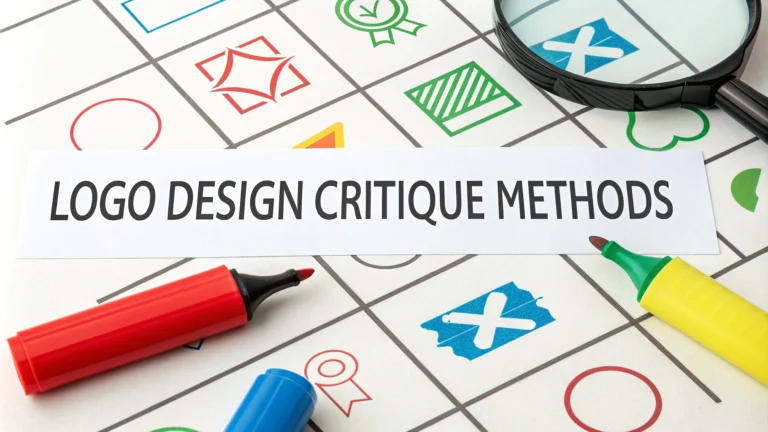Professional logo design critique methods help identify strengths and weaknesses in visual branding elements.
Essential Elements to Analyze
- Simplicity: Check if the logo works at different sizes and remains recognizable
- Versatility: Test the logo in both color and monochrome versions
- Memorability: Evaluate how easily the design can be recalled
- Relevance: Assess if it matches the brand’s identity and target audience
- Timelessness: Consider if the design will remain effective for years
Technical Assessment Checklist
- ✓ Color harmony and contrast
- ✓ Typography readability and spacing
- ✓ Shape balance and proportions
- ✓ Grid alignment and symmetry
- ✓ File format compatibility
Practical Critique Steps
- First Impression Test: Record initial reactions within 5 seconds
- Size Test: Review at favicon size (16×16 pixels) and billboard scale
- Context Review: Place the logo in real-world applications (business cards, websites, merchandise)
- Competition Compare: Analyze against competitor logos in the same industry
- Target Audience Feedback: Gather responses from potential customers
Common Logo Problems to Look For
| Issue | Solution |
|---|---|
| Too complex | Remove unnecessary elements |
| Poor contrast | Adjust color values |
| Dated appearance | Update typography and styling |
| Generic design | Add unique brand elements |
Professional Review Resources
- Behance – For design community feedback
- Logo Design Love – Expert critiques and case studies
- Dribbble – Professional designer feedback platform
Contact the American Institute of Graphic Arts (AIGA) at www.aiga.org for professional logo design critique services and resources.
Logo Testing Tools
- Adobe Illustrator for vector scaling tests
- Photoshop for mockup applications
- Online logo makers for quick comparisons
- Color blindness simulators for accessibility checking
Request feedback from multiple sources including designers, potential customers, and industry experts for a well-rounded critique.
Implementation Guidelines
- Documentation: Record all feedback systematically
- Timeline: Allow 2-3 weeks for comprehensive critique
- Iterations: Plan for 3-5 revision cycles
- Budget: Allocate resources for professional review if needed
Advanced Analysis Methods
Digital Performance Testing
- Social media profile adaptation
- Website loading impact
- Email signature compatibility
- Mobile responsiveness
Brand Consistency Check
- Color palette adherence
- Brand voice alignment
- Industry standards compliance
- Cultural sensitivity verification
Legal Considerations
| Aspect | Action Required |
|---|---|
| Trademark search | Check existing registrations |
| Copyright clearance | Verify original design elements |
| Usage rights | Document ownership terms |
Conclusion
Effective logo critique requires systematic evaluation across multiple dimensions including technical execution, brand alignment, and practical application. Regular assessment using these methods ensures the logo remains a strong asset for brand identity. Implement feedback methodically and document changes for future reference.
Remember to periodically review the logo’s performance and make necessary updates while maintaining core brand recognition elements. Success in logo design comes from balancing timeless appeal with contemporary relevance.
FAQs
- What are the key elements I should look for when critiquing a logo design?
Evaluate the logo’s simplicity, scalability, memorability, relevance to the brand, color harmony, typography, negative space usage, and versatility across different applications. - How do I assess if a logo design is appropriately simple?
Check if the logo can be easily recognized at a glance, works well at small sizes, and contains no unnecessary decorative elements that could distract from the core message. - What role does color psychology play in logo critique?
Analyze if the chosen colors align with the brand’s personality, industry standards, target audience expectations, and whether they create appropriate emotional responses while maintaining effectiveness in both color and monochrome versions. - How can I evaluate a logo’s originality and uniqueness?
Research similar logos in the industry, check for visual clichés, ensure it doesn’t closely resemble existing designs, and verify it stands out from competitors while remaining relevant to the sector. - What technical aspects should be considered when critiquing a logo?
Examine vector quality, minimum size legibility, print and digital compatibility, file format availability, and how well it reproduces across different mediums and materials. - How do I assess the typography in a logo design?
Evaluate font choice appropriateness, legibility, spacing, custom modifications, hierarchy if multiple fonts are used, and whether it complements the symbolic elements. - What makes a logo design timeless versus trendy?
Look for classic design principles, avoid current design fads, ensure it doesn’t rely on effects that may become dated, and check if it could remain relevant for 5-10 years minimum. - How can I evaluate a logo’s versatility?
Test the logo across different applications (digital, print, merchandise), various backgrounds, sizes, and orientations to ensure it maintains its impact and legibility. - What role does negative space play in logo critique?
Examine how effectively the space between and around elements is used, whether it creates additional meaning or clever visual elements, and if it contributes to the overall balance. - How do I assess if a logo effectively communicates the brand’s values?
Evaluate if the design elements, style, and overall aesthetic align with the company’s mission, target audience, industry position, and core message.







